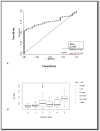Immunodiagnosis of opisthorchiasis using parasite cathepsin F
- PMID: 26344868
- PMCID: PMC4917378
- DOI: 10.1007/s00436-015-4703-9
Immunodiagnosis of opisthorchiasis using parasite cathepsin F
Abstract
Opisthorchis viverrini, a food-borne trematode parasite endemic in the lower Mekong countries, is conventionally diagnosed by stool examination. However, parasitological stool-based diagnosis can be unreliable in light infections. The goal of this study was to develop the immunodiagnosis of opisthorchiasis using cathepsin F cysteine protease of O. viverrini in both indirect and sandwich ELISA assays. A recombinant O. viverrini cathepsin F (rOv-CF) of 40 kDa was expressed in E. coli strain BL21 (DE3), affinity purified, and deployed in ELISA assays. Human sera from 272 cases were investigated by indirect rOv-CF-based ELISA. Positive antibody response to rOv-CF was found in 137 out of 272 cases (50.37 %) using a cutoff OD (0.400) determined by ROC analysis. In comparison to parasitological stool examined for fluke eggs, the gold standard, the rOv-CF indirect ELISA showed a sensitivity and specificity of 62.1 and 84.05 %, respectively. Serum antibody levels correlated well with egg counts per gram feces (EPG) (P < 0.001). In addition, chicken IgY antibody raised against rOv-CF was tested in a sandwich ELISA for detection of coproantigen in the feces of experimentally infected hamsters. The sandwich ELISA using this chicken IgY in combination with rabbit antibody to O. viverrini somatic antigens showed sensitivity and specificity of 93.3 and 78.57 %, respectively. Together, these findings indicated the potential of rOv-CF for diagnosis of opisthorchiasis, including for uses with chicken IgY for detection of coproantigens of O. viverrini.
Keywords: Cathepsin F; Coproantigen detection; Food-borne trematodiasis; Immunodiagnosis; Opisthorchiasis; Opisthorchis viverrini.
Figures




Similar articles
-
Chicken IgY-based coproantigen capture ELISA for diagnosis of human opisthorchiasis.Parasitol Int. 2017 Aug;66(4):443-447. doi: 10.1016/j.parint.2015.10.011. Epub 2016 Apr 29. Parasitol Int. 2017. PMID: 27140305 Free PMC article.
-
Evaluation of liver fluke recombinant cathepsin B-1 protease as a serodiagnostic antigen for human opisthorchiasis.Parasitol Int. 2012 Mar;61(1):191-5. doi: 10.1016/j.parint.2011.05.009. Epub 2011 Jun 17. Parasitol Int. 2012. PMID: 21704728 Free PMC article.
-
Diagnostic values of parasite-specific antibody detections in saliva and urine in comparison with serum in opisthorchiasis.Parasitol Int. 2012 Mar;61(1):196-202. doi: 10.1016/j.parint.2011.06.009. Epub 2011 Jun 17. Parasitol Int. 2012. PMID: 21704727
-
Immunology and molecular biology of Opisthorchis viverrini infection.Acta Trop. 2003 Nov;88(3):195-207. doi: 10.1016/j.actatropica.2003.02.002. Acta Trop. 2003. PMID: 14611874 Review.
-
[Present Situation of Opisthorchiasis in Vientiane Capital, Lao Peoples' Democratic Republic].Nihon Eiseigaku Zasshi. 2017;72(2):101-105. doi: 10.1265/jjh.72.101. Nihon Eiseigaku Zasshi. 2017. PMID: 28552889 Review. Japanese.
Cited by
-
The omic approach to parasitic trematode research-a review of techniques and developments within the past 5 years.Parasitol Res. 2016 Jul;115(7):2523-43. doi: 10.1007/s00436-016-5079-1. Epub 2016 Apr 28. Parasitol Res. 2016. PMID: 27126082 Review.
-
An Innovative Test for the Rapid Detection of Specific IgG Antibodies in Human Whole-Blood for the Diagnosis of Opisthorchis viverrini Infection.Trop Med Infect Dis. 2022 Oct 17;7(10):308. doi: 10.3390/tropicalmed7100308. Trop Med Infect Dis. 2022. PMID: 36288049 Free PMC article.
-
Multi-epitope protein production and its application in the diagnosis of opisthorchiasis.Parasit Vectors. 2024 May 7;17(1):206. doi: 10.1186/s13071-024-06285-7. Parasit Vectors. 2024. PMID: 38715089 Free PMC article.
-
Production and Immunological Characterization of scFv Specific to Epitope of Opisthorchis viverrini Rhophilin-Associated Tail Protein 1-like (OvROPN1L).Trop Med Infect Dis. 2023 Mar 6;8(3):160. doi: 10.3390/tropicalmed8030160. Trop Med Infect Dis. 2023. PMID: 36977161 Free PMC article.
-
Epidemiology and Control of Opisthorchis viverrini Infection: Implications for Cholangiocarcinoma Prevention.Recent Results Cancer Res. 2023;219:27-52. doi: 10.1007/978-3-031-35166-2_3. Recent Results Cancer Res. 2023. PMID: 37660330
References
-
- Akai PS, Pungpak S, Chaicumpa W, et al. Serum antibody responses in opisthorchiasis. Int J Parasitol. 1995;25:971–973. - PubMed
-
- Cornelissen JBWJ, Gaasenbeek CPH, Borgsteede FHM, et al. Early immunodiagnosis of fasciolosis in ruminants using recombinant Fasciola hepatica cathepsin L-like protease. Int J Parasitol. 2001;31:728–737. - PubMed
-
- Dixit AK, Dixit P, Sharma RL. Immunodiagnostic-protective role of Cathepsin L cysteine proteinases secreted by Fasciola species. Vet Parasitol. 2008;154:177–184. - PubMed
Publication types
MeSH terms
Substances
Grants and funding
LinkOut - more resources
Full Text Sources
Other Literature Sources

